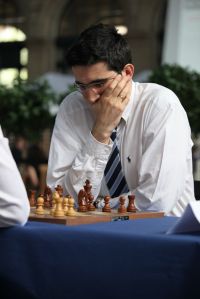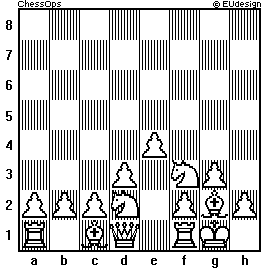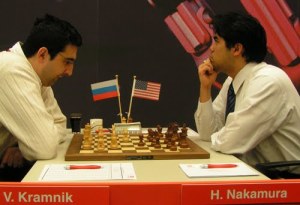Category: chess
King’s Indian Attack
At best I am a mediocre chess player. But I like the game and want to get better. I have been playing some games over at Chess World and mostly figuring out I need to work on my game. Lately I have been studying a particular opening for White, the King’s Indian Attack. This is a well-known opening, and it is well documented in the chess literature.
Here is the basic position one aims for with the White pieces after the first few moves:
One can get to this position by different orders of moves. It’s not that complicated, and it puts White in a nice asymmetrical position that allows for various attacking options. I am not having too much trouble getting to the King’s Indian Attack position, but I don’t know what to do next. So I am contemplating the possibilities. What I am finding is that the King’s Indian Attack provides a slightly better opening than what I was doing before, which was a more symmetrical attack on the center–a kind of basic “take the high ground” idea one learns as a first principle when one is a beginner. My understanding of chess has been at the beginner level for a long time. I figure a little study couldn’t hurt, though I only have time for a little.
For more insight, here are a couple of videos that explain how the King’s Indian Attack works:
Bobby Fischer Against the World
This film could also be titled The Tragedy of Bobby Fischer. Though I hate to say it, I feel much of the blame should fall on Bobby’s mother who abandoned him for her social causes and taught him, by her example, to make oneself the center of the world. Chess was Fischer’s escape, but chess is neither a loving parent nor a philosophy to sustain one through the dark hours. Still, and though he may have had a psychological disease, Fischer must bear at least most of the blame for his own choices and his spiritual darkness. And yet, and ironically, what a truly marvelous chess player and an example of dedication to excellence. As they say in the film, what he left us were his games.
And if you are curious: Fischer vs Spassky 1972 Game 6
>Chess and "undirected" thinking
>
Si les insomnies d’un musicien lui font créer de belles oeuvres, ce sont de belles insomnies.
~ Antoine de Saint-Exupéry

Vladimir Kramnik
Chess World Champ 2000-2007
I’ve been wondering about creativity lately.
In 1926 Graham Wallas proposed a model to describe the process of creativity. This model followed four steps: 1) Preparation, 2) Incubation, 3) Illumination, and 4) Verification. There are two reasons why this model is historically important. First is the implication that creativity can be structured to some degree, and thus directed towards particular ends. The second is the recognition that creativity works both consciously and subconsciously, or a mix of directed and undirected thinking.
For many, the idea that creativity can be structured or controlled to some degree is of great significance. Think of the need in business to be innovative in order to remain competitive. Much has been written in this area and it is fascinating stuff. The mystery, though, is the subconscious aspect of creativity.
When we think about the game of chess we might assume that a pure Spock-like logical mind would be the best. Chess is a game of carefully calculated moves designed to find advantages against an opponent until a win is secured. But a pure emotionless rationality doesn’t work in chess. Sure, Deep Blue, the super computer that was able to beat the world’s greatest chess champion, Gary Kasparov, had no emotion, but it could also calculate around 2 million possible moves per second. Kasparov, on the other hand, can only calculate around 5 moves per second. (Even then, Kasparov still won one game and drew three out of six against Deep Blue). The human brain has limitations when it comes to the heavy lifting kinds of work that computers can do. Therefore, us humans need (and have) a different process for calculating chess moves. The answer, surprisingly, is the role our emotions and subconscious play in the decision making process.
Our subconscious is an interesting animal when it comes to creativity. When we tackle a problem our conscious mind is actively engaged, even working overtime. But so is our subconscious. When we get stuck and can’t find a solution we may disengage our conscious mind and move on to something else, but our subconscious mind can still be working on the problem. That’s why solutions often hit us when we are far from problem solving mode – like when we are just about to fall asleep at the end of a long day. Moments like these are examples of undirected thinking. Often it is best to get away from problem solving mode and do mundane activities like checking email or going for a walk, in order to let one’s subconscious to percolate on the problem.
There is an interesting story of undirected thinking in a recent chess tournament. Every year a number of the world’s top chess players gather in the Dutch seaside town of Wijk aan Zee for the Corus Chess tournament. In 2010 the reigning U.S. champion, Hikaru Nakamura, was tearing up the tournament, and not without a little smugness. Former world chess champion Vladimir Kramnik was to play Nakmura next. The night before Kramnik was pondering his strategy. He suspected the kind of chess opening Nakmura would choose, but he was struggling to find a way to neutralize that choice. He worked on it all afternoon and finally had to take a break. Later, in a classic moment of undirected thinking, the solution hit him:
“Around 3 o’clock last night I was pretty annoyed. I hadn’t found anything yet and it’s not possible you can equalize with the Dutch. Finally I had a shower, where I realized that I just shouldn’t take on e4!”
Saying he shouldn’t take on e4 is a way of describing in chess language that the solution against Nakamura is to not fall into the trap set by Nakamura’s opening strategy. In other words, even though he needed to take a break from actively thinking about his upcoming game, Kramnik’s subconscious continued on towards a solution which then came to him in the shower. The next day Nakamura played the opening Kramnik was expecting and Kramnik was able to handily neutralize the opening and play on to a win.
We have all had moments like that where, when we least expect it, a solution pops into our head as though out of nowhere. The fact is, it was there, just not in our conscious mind, but in our subconscious. The story above goes to show as well that even in the profound mental struggles of world class chess the human mind works as it does for all of us, as a mix of conscious and subconscious activities that can lead to both logically calculated thoughts as well as flashes of intuition. It is all part of how our rationality works, and the more we understand its complexities the better we might be able to exploit both directed and undirected thinking in a holistic creative process.
If you are interested in hearing Vladimir Kramnik talk about his win against Hikaru Nakamura, you can view his post-game press conference below. Note: If the credits at the beginning say “Round 1 Jan Smeets…”, that’s a mistake. This is all Kramnik.
>26 individuals simultaneously lose
>On some show called Your Next Move, Gary Kasparov played chess against 26 individuals simultaneously. Here are some highlights, with Nigel Short narrating:
Watching others play chess is not always the the most exciting thing to do. It’s better to play. But it is fascinating to see someone so capably play 26 simultaneous games, and then win them all. Of course one could say that is expected from Kasparov. The goal, as one of his opponents, is to hold out as long as possible and then recognize when it is time to concede defeat.
>a triple sacrifice
>Here is a recent game in which I found myself in a tight spot, thought the game was lost, but then used two sacrifices to turn the game to my advantage. In the end my opponent was forced to resign or face an inevitable checkmate. I was playing white. My opponent was rated slightly higher than I.
The game began ordinarily enough with 1.e4 e5. Lately I’ve been trying different openings, but this time I went with the most common opening. Then I tried 2. Nc3 which turned it into a Vienna game. But by 27. … Nf8 I was feeling a bit cramped and disorganized. So I got an idea and played 28.Nh8. This knight sacrifice enticed his king to take my knight the next move so I could eventually set up 29.Rbh1, which I hoped would cause a little panic in my opponent. After a number of subsequent positions where I felt the game was probably lost I then played 36.Qxf8, sacrificing my queen and forcing 36. … Rxf8. Then at 38. … Qc7 his queen, brought in to save the position becomes a target which leads to 39. … Rf7. At this point the game is essentially over. I take the bishop, sacrificing my rook, and he now has only his king, rook and some pawns ripe for the taking. At 47.Rxb6 he looses his last rook and resigns.
I am sure my playing was full of holes, and I blocked in my bishop and knight and thus had to essentially play without them, but I like how I was able to wrap up the game. And I especially like using sacrifices. There’s something satisfying in that.
This was played on Chessworld.
>trying out the modern defense
>Here is a win from two days ago. My opponent was rated at 1615 and I at 1461, so it was a good win for me. I was also playing black. As usual, this game was played at ChessWorld.
I used this game to try the Modern Defense, a defense I have used several times. This strategy is all about attacking and undermining “White’s “ideal” position without directly attempting to occupy the center.” But I can’t say I really know the Modern. After the first several moves I’m just flying by the seat of my pants.
1.e4 g6
2.d3 Bg7
3.Qf3 e5
4.Be2 Nc6
5.c3 Nge7
6.h4 d6
7.b4 Be6
8.Bg5 h6
9.Bxe7 Qxe7
10.a4 O-O
11.Qg3 d5
12.exd5 Bxd5
13.h5 e4
14.hxg6 fxg6
15.d4 Rae8
16.Qxg6 Rf6
17.Qg3 Ref8
18.Nh3 Qd6
19.Qxd6 cxd6
20.Nd2 b6
21.c4 Bf7
22.Nxe4 Re6
23.Bf3 Nxd4
24.Rc1 Re5
25.O-O Bh5
26.Nxd6 Nxf3+
27.gxf3 Rxf3
28.b5 Rxh3
29.Nc8 Rg5+ {White king mated} 0-1
>the modern (neophyte) defense
>Below is a recent game of mine on Chessworld.net. My opponent is the highest rated player that I have beat by checkmate. At the time he was rated 1577 and I 1435 on Chessworld, which puts both of us in the strong beginner classification. I was playing black. (You can flip the board to see the game as I saw it.)
We started with 1.e4 g6 2.d4 Bg7. My goals here was to try and learn what is called the Modern Defense. So I followed the book, as it were, for the first several moves. I allowed* him to advance quickly and gain valuable territory, but my defenses were still relatively strong and I ended up capturing a number of his pieces – frequently as trades – which changed his position somewhat. At 10.Bxe6 I feel he began to blunder a bit, advancing his Bishop without a clear strategy. He was hoping that my d pawn would take him, setting up for his knight to fork my Queen and rook. All I had to do was not fall for it. And then, by bringing my knight deep into his territory, I was able to open up the g file, which became his undoing. Not that I had a clear strategy at this point either. The end, however, took a fair amount of thinking on my part in terms of move order.
* At this stage in my development I can’t really say the I “allow” my opponent to do anything. I don’t have that much power on the board.
>tinkering & puttering with chess & computers
>I have been tinkering a bit with the computer chess game pychess Philidor 0.8.1, which runs on Linux (I’m running Ubuntu). I then tried loading in some chess engines (Fruit 2.1, Glaurung 2.0.1, etc.). I can’t say that I have achieved actually loading the chess engines. The game might still be using the built in engine from pychess. Anyway, I tried a quick game at the beginner level. Then I saved the game as a PGN file. And then I searched for a PGN viewer (I chose Chessflash for now) that would allow me to upload it as HTML to this blog. My results are below.
As you can see the beginner level is hopelessly terrible as an opponent. But that might be the pychess engine, so I have to figure that out.* And I don’t exactly like the Chessflash graphics, but it’s free. Anyway, puttering around with both chess and computers is kinda fun at times.
* Figured it out. I was still using the pychess engine. When I try the Fruit 2.1 engine at beginner level it suddenly starts playing like it’s trying to win.
>Being changed by the digital: A brief consideration of chess before & after computers
>There is something truly beautiful about human creativity and intuition. We can see that beauty in the way chess was played a hundred or more years ago. But today the game of chess is dominated by the use of computers, not merely to play games but to analyze them. Chess aficionados and serious players constantly use chess ‘engines’ to analyze games. Computers are changing the way we play chess, but is that a good thing? Are we losing the beauty of the game? Can we see correlations in other areas of life? Are we dominated too much by technology?
I am interested in this topic not merely for myself, but also for my kids. To what degree should I steer them away from technology and to what degree should I make sure they know, use, and understand technology? I don’t want to to be a Luddite, but I don’t want my kids to be dominated by technology.
Here is a wonderful analysis of both the impact of technology on chess/life and a classic game from chess’ romantic era (19th century):
What a beautiful game. Known as “The Evergreen” this game shows two humans matching wits and daring in a game of strategy and tactics that, in the end, is a kind of work of art. And yes, many of the most famous games of chess have names – another great aspect of chess.
Note: The analysis in the video is by a chess player known in cyberspace as kingcrusher. His real name is Tryfon Gavriel and he is the main force behind Chessworld.net. He has analyzed many chess games like this on youtube.




